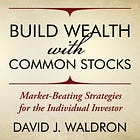Course Module 108: Defining the Value Proposition
How to gain an understanding of a business's competitive advantages

Summary
The value proposition of a publicly traded company is the sum of the competitive advantages of its products and services in the markets it serves.
Uncovering the business’s value proposition before taking an ownership slice is crucial when researching a targeted stock.
Read the filings submitted by senior management to the Securities and Exchange Commission (SEC), such as the 10-K annual reports, 10-Q quarterly reports, and 8-K current events.
If unable to define or understand the enterprise’s value proposition, consider taking a pass on the stock.
Understanding the products or services and competitive advantages with conviction is essential to thriving retail-level stock investors.
How well investors know and understand the competitive landscape of the products or services of the publicly traded companies represented by the shares they own is a prerequisite to building a market-beating or alpha-achieving portfolio of common stocks.
The primary role of do-it-yourself investors is to uncover the organization’s value proposition. An enterprise’s value proposition is the sum of the competitive advantages of its products or services in the markets it serves, including the level of attraction of the goods or services to its customers.
When conducting due diligence on a business, ask, “What value do the products or services offer to existing and potential consumers?” If in the general market for either, would we purchase the goods or services of the company?
Imagine a mutual friend as the managing partner of a similar, privately held enterprise who invited us to buy in as partners. Assuming we have the necessary funds, do we accept the offer?
Our answers to these hypothetical questions validate an understanding and confidence in the prospects of the targeted business from the value proposition or competitive advantage toward continued growth and prosperity, as reflected in the stock price over time.
Publicly traded companies exhibiting clear and compelling value propositions are as coveted as solid returns on management, attractive valuation multiples, and low downside risks.
Course Module 108 Syllabus
Subject matter objective: How to define the value proposition of the products or services of a targeted company and then explain it with confidence via an elevator pitch. At a minimum, investors should first assess the business’s competitive advantages when conducting due diligence on a stock.
Researching a company’s intrinsic value using its SEC or other public filings.
How to gauge the competitive advantages of the products or services.
In the wisdom of Peter Lynch, illustrate the value proposition with a crayon.
Writing the value proposition in the form of an elevator pitch.
The crowd buys and sells what sounds and feels good or doesn’t. Avoid the crowd.
Thoughtful, disciplined, and patient investors begin their research or due diligence by defining the value proposition.
Module 108 voluntary action items and suggested resources.
The Intrinsic Value of an SEC Filing
Beyond anything already known about the products or services of the company, retail investors have a myriad of public information available to vet the value proposition. The most reliable data on hand for the enterprise lies in its filings with the US Securities and Exchange Commission or SEC.
Thoughtful and disciplined investors read corporate filings to the SEC, such as the 10-K annual reports, 10-Q quarterly reports, and 8-K current events. These required filings are the primary public resources for due diligence on the enterprise’s value proposition and its products or services. Access this information on the investor relations section of the company’s website, an online broker, or a favorite investing website.
Take the time to delve into the organization’s online presence, including its website, social media, marketing channels, and public and investor relations. As the starting point of diligent investment research, reading the Form 10-K Annual Report and reviewing the investor relations site are priorities one and two for independent investors.
For example, the 10-K, mainly the section titled Item 1 Business, is where management discusses the enterprise with vigor. Topics include the background and history of the company, corporate strategy, specific products and services, markets and distribution, competition, supply chains, research and development, intellectual property, foreign and domestic operations, and other related items specific to the industry. Despite being detailed to the point of sleep-inducing, the information provides a roadmap of the products’ or services’ potential to propel the stock price upward over a long-term holding period.
The investor relations website and SEC filings from Apple, Inc. (NASDAQ: AAPL) are among the best-prepared and easy to understand of the S&P 500 companies. But, on the contrary, transparency is often weak or elusive in many enterprises.
QVI challenges individual investors prone to skip annual reports and other SEC filings to find organizational, product, regulatory, and financial facts about the company they were unaware of before reading. To be sure, these documents are avalanches of legalese and numbers crunching. However, a thorough read often uncovers slices of information that bring us inside—at least on a virtual level—the plants, stores, e-commerce operations, C-suites, and boardrooms.
Competitive Advantages of the Products or Services
Profitable retail common stock portfolios resemble collections of owned slices of well-managed companies producing in-demand products or services with durable competitive advantages.
Based on the relentless commitment to price and quality, how do thoughtful investors define the competitive advantages of the product or services offered by the company and the perceived enduring value relative to the stock’s market price?
One recommended simplified approach that gauges how the company’s value proposition rewards each of its stakeholders is up next.
Illustrate the Value Proposition with a Crayon
In his book, Beating the Street (New York: Simon & Schuster, 1993), Peter Lynch assesses the importance of understanding what we are investing in without experiencing analysis paralysis:
Never invest in any idea you can’t illustrate with a crayon.
The thought came to Lynch after he observed a class of middle school students who formed an investment club under the direction of their teacher. Lynch noted that the combined stock picks of the student investment club outperformed the S&P 500 Index by a wide margin. Lynch and his student investors reduced the value proposition to a metaphorical crayon sketch that any investor could easily understand and communicate.
Can we illustrate the company’s value proposition behind our favorite stocks with a crayon, the symbolic equivalent of a short sentence or phrase?
Successful do-it-yourself investors won’t buy something because it sounds or feels right; alternatively, they allocate hard-earned dollars to the common shares of businesses that are understood and appreciated. Unfortunately, the value proposition is often overlooked or taken for granted by retail investors. At the other extreme, institutional investors, such as portfolio managers and analysts, tend to over-analyze the value proposition of products or services of selected companies with piles of deep-dive research to justify the fees and bonus structure. Nevertheless, underperforming retail-level stock pickers are buying shares of enterprises despite limited knowledge of what each produces or how it benefits the target market.
Thoughtful, disciplined, and patient investors know that the common stocks of companies providing valuable, in-demand products and services endure across market cycles, despite a few erratic price movements in between from the nearsightedness of the crowd, inclusive of Main Street individuals and Wall Street professionals.
After reading the required disclosures and background information, we’ll continue exploring strategies that help define a company’s value proposition or competitive advantages, followed by a module review, action items, and additional resources.
Disclosure: I/we have a beneficial long position through direct ownership of AAPL common shares in our family portfolio. I wrote this course module myself, and it expresses my own opinions. I am not receiving compensation for it other than from Substack paid subscriptions.
Additional disclosure: David J. Waldron’s Quality Value Investing course modules, research reports, and real-time portfolios are for informational purposes only. The accuracy of the data cannot be guaranteed. Narrative and analytics are impersonal, i.e., not tailored to individual needs nor intended for portfolio construction beyond his family portfolio, which is presented solely for educational purposes. David is an individual investor and author, not an investment adviser. Readers should always engage in their own research or due diligence and consider (as appropriate) consulting a fee-only certified financial planner, licensed discount broker/dealer, flat fee registered investment adviser, certified public accountant, or specialized attorney before making any investment, income tax, or estate planning decisions.
About the Writer
David J. Waldron is contributing editor of Quality Value Investing and author of the international-selling book, Build Wealth with Common Stocks: Market-Beating Strategies for the Individual Investor. David’s mission is to inspire the achievement of his readers’ financial goals and dreams. His work has been featured on Seeking Alpha, TalkMarkets, ValueWalk, MSN Money, Yahoo Finance, QAV (Australia’s #1 Value Investing Podcast), Money Life with Chuck Jaffe, The Acquirer’s Multiple, Amazon.com, Barnes & Noble, Apple Books, the BookLife Prize, and Publisher’s Weekly. David received a Bachelor of Science in business studies as a Garden State Scholar at Stockton University and completed The Practice of Management Program at Brown University.
Preview David’s Book
Readers can preview Build Wealth with Common Stocks, where David includes frequent references to the value proposition based on applying thought, discipline, patience, and a pinch of common sense to quality-based value investing:
Bonus: Founding Subscribers of QVI on Substack are eligible to receive a personalized complimentary copy of the case laminate hardcover edition of the book from the author.
Keep reading with a 7-day free trial
Subscribe to Quality Value Investing to keep reading this post and get 7 days of free access to the full post archives.






